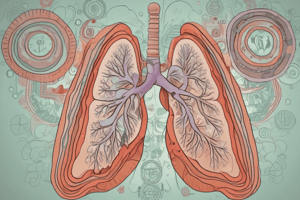Podcast
Questions and Answers
What is the primary goal of treating COPD?
What is the primary goal of treating COPD?
- Alleviating symptoms and reducing exacerbations (correct)
- Increasing daily activity limitations
- Eliminating genetic predisposition
- Preventing disease progression
What diagnostic test is especially important in the diagnosis of COPD?
What diagnostic test is especially important in the diagnosis of COPD?
- Pulse oximetry
- Complete Blood Count (CBC)
- Chest X-ray
- Spirometry, particularly FEV1/FVC ratio (correct)
Which of the following is NOT a causative factor for COPD?
Which of the following is NOT a causative factor for COPD?
- Regular exercise (correct)
- Genetic predisposition
- Tobacco smoke
- Infections
Flashcards are hidden until you start studying
Study Notes
- Chronic Obstructive Pulmonary Disease (COPD) is a progressive airway disease, characterized by chronic bronchitis and emphysema.
- COPD is marked by obstructed airflow, making it difficult to breathe.
- Treatment for COPD focuses on symptom relief and preventing exacerbations.
- Tobacco smoke, pollution, infections, and genetics can contribute to COPD development.
- Key symptoms of COPD include chronic cough, sputum production, dyspnea, and chest tightness.
- Severe COPD may limit daily activities and result in more severe symptoms.
- Diagnostic tests for COPD include chest X-rays, complete blood counts, pulse oximetry, and spirometry assessments, specifically FEV1/FVC.
Studying That Suits You
Use AI to generate personalized quizzes and flashcards to suit your learning preferences.





